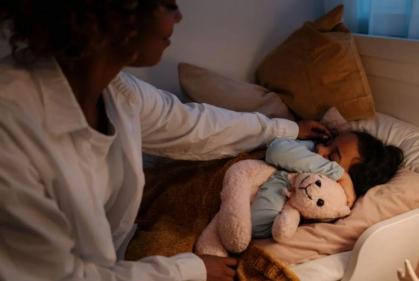Deciding whether your toddler has a common cold or the flu is difficult because flu symptoms are so similar to cold symptoms. However, if your toddler is sick in flu season and she shows the typical symptoms, she more than likely has the flu. Symptoms include a sudden fever that is typically 38.3 degrees Celsius (101 degrees Fahrenheit) or higher, body aches, headache, chills, and fatigue. These initial symptoms will be followed by respiratory distress like a dry cough and a runny nose.
The fever is the key to knowing if it is a cold or the flu. In cases of a cold, head or chest congestion and a cough will most likely be present before a fever hits. With the flu, the fever is usually the first indication and comes on suddenly. Your toddler will also lose her appetite, have a sore throat, and possibly have swollen glands. Abdominal pain can sometimes be present with the flu, as well as diarrhoea and vomiting.
The flu virus is transmitted through the air and is fairly easy to contract. Schools, crèches, and anywhere that children gather are a playground for the flu virus. The best thing to do for your toddler when she has the flu is to make sure that she get lots of rest and drinks plenty of fluids. Most times, she won’t want to eat much, but you can offer frozen fruit pops and soups and broths to make sure that they get the fluids she needs. You can also give your toddler children’s pain relievers to help with the fever and body aches.
Antibiotics will not do much to help with the flu because the cause is viral and not bacterial. However, this does not mean that you should not consult your toddler’s doctor. There are situations that warrant a trip to the doctor:
• If your child has a fever of 39.4 degrees Celsius or higher;
• If your child’s cough does not seem to improve after one week;
• If your child has underlying health issues and comes down with the flu;
• If there is an earache along with the flu;
• If there is wheezing or difficulty breathing;
• If your child shows signs of dehydration;
• If your child seems to get well, then quickly gets sick again.
The fever is the key to knowing if it is a cold or the flu. In cases of a cold, head or chest congestion and a cough will most likely be present before a fever hits. With the flu, the fever is usually the first indication and comes on suddenly. Your toddler will also lose her appetite, have a sore throat, and possibly have swollen glands. Abdominal pain can sometimes be present with the flu, as well as diarrhoea and vomiting.
The flu virus is transmitted through the air and is fairly easy to contract. Schools, crèches, and anywhere that children gather are a playground for the flu virus. The best thing to do for your toddler when she has the flu is to make sure that she get lots of rest and drinks plenty of fluids. Most times, she won’t want to eat much, but you can offer frozen fruit pops and soups and broths to make sure that they get the fluids she needs. You can also give your toddler children’s pain relievers to help with the fever and body aches.
Antibiotics will not do much to help with the flu because the cause is viral and not bacterial. However, this does not mean that you should not consult your toddler’s doctor. There are situations that warrant a trip to the doctor:
• If your child has a fever of 39.4 degrees Celsius or higher;
• If your child’s cough does not seem to improve after one week;
• If your child has underlying health issues and comes down with the flu;
• If there is an earache along with the flu;
• If there is wheezing or difficulty breathing;
• If your child shows signs of dehydration;
• If your child seems to get well, then quickly gets sick again.










